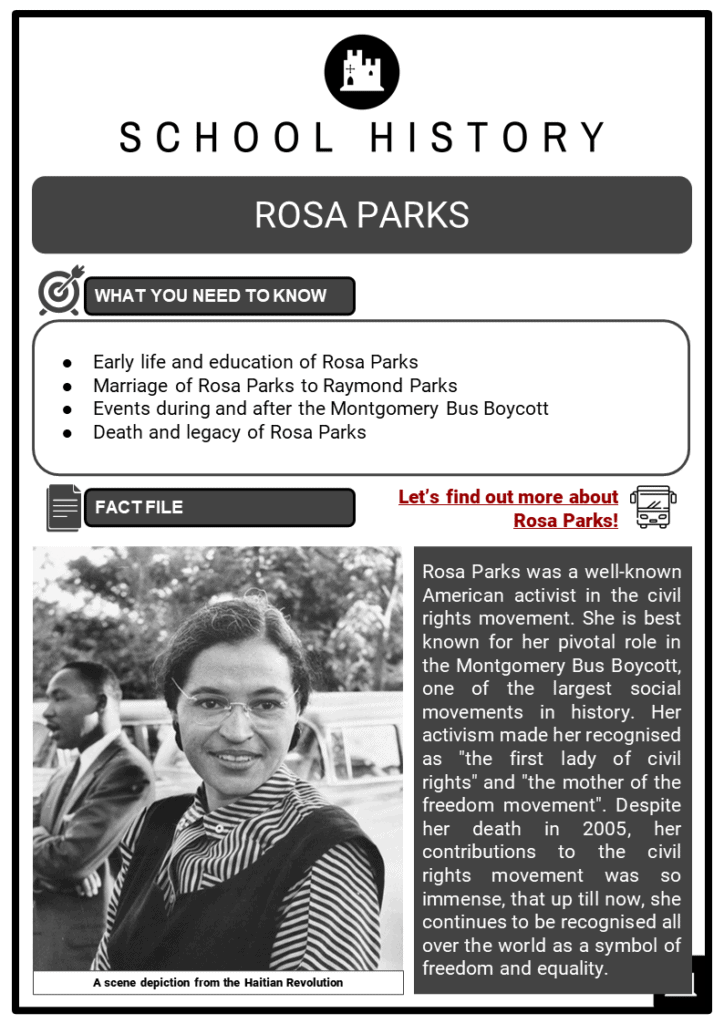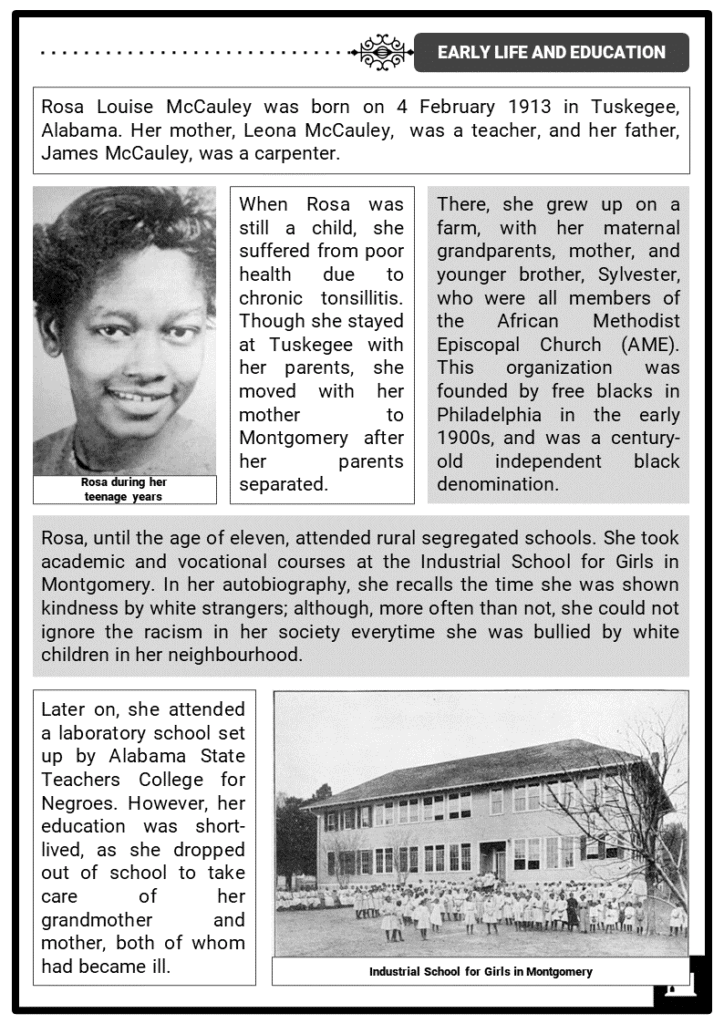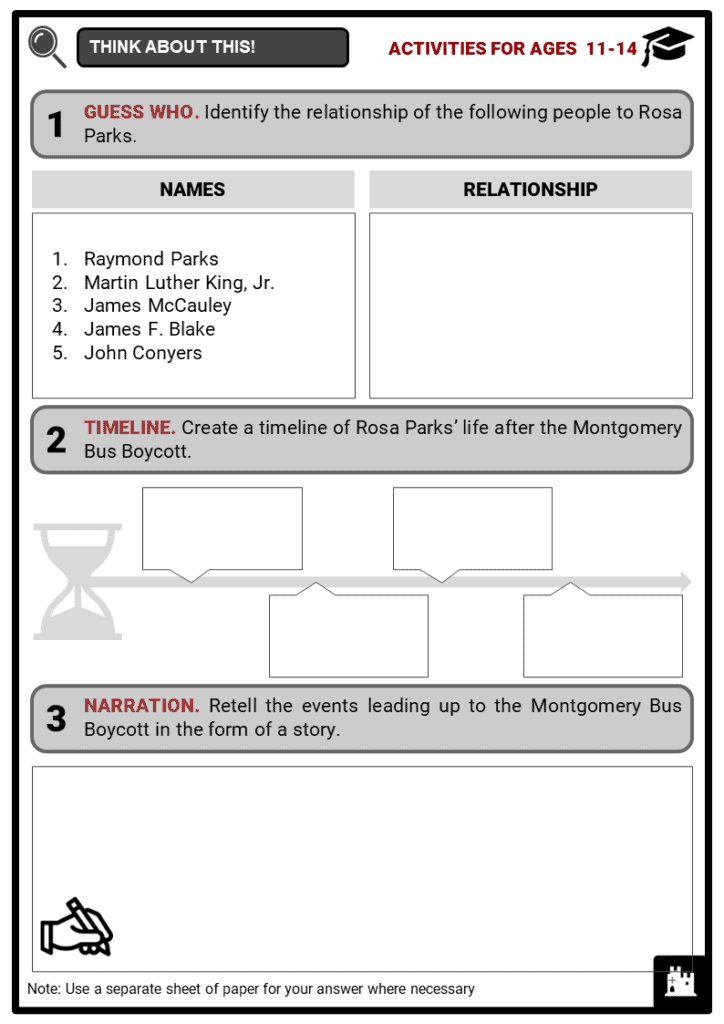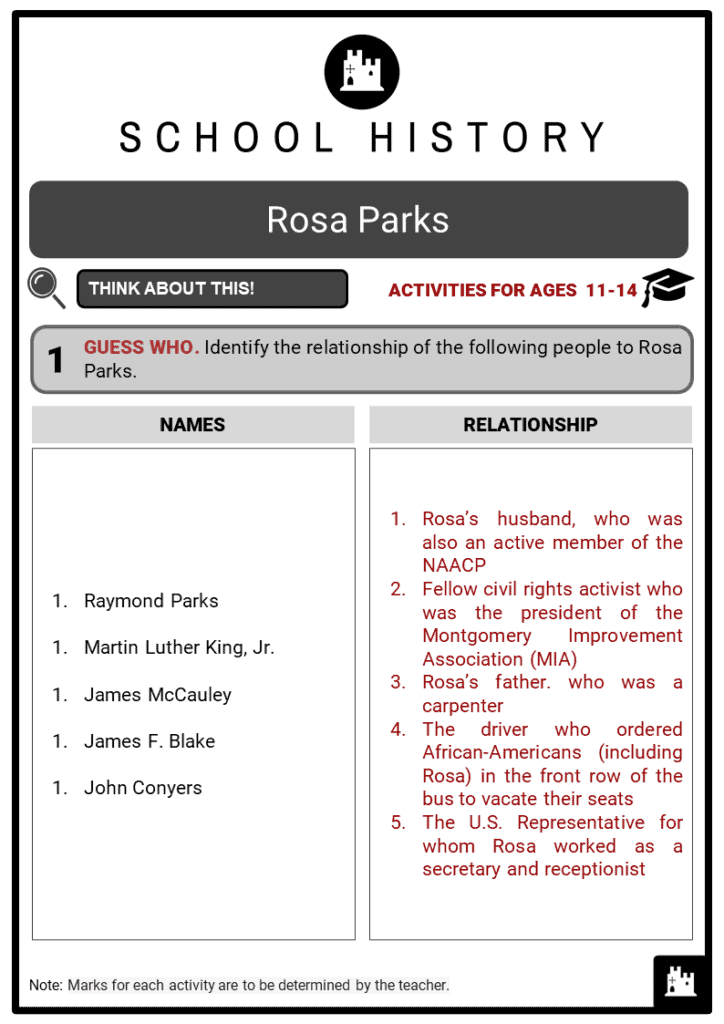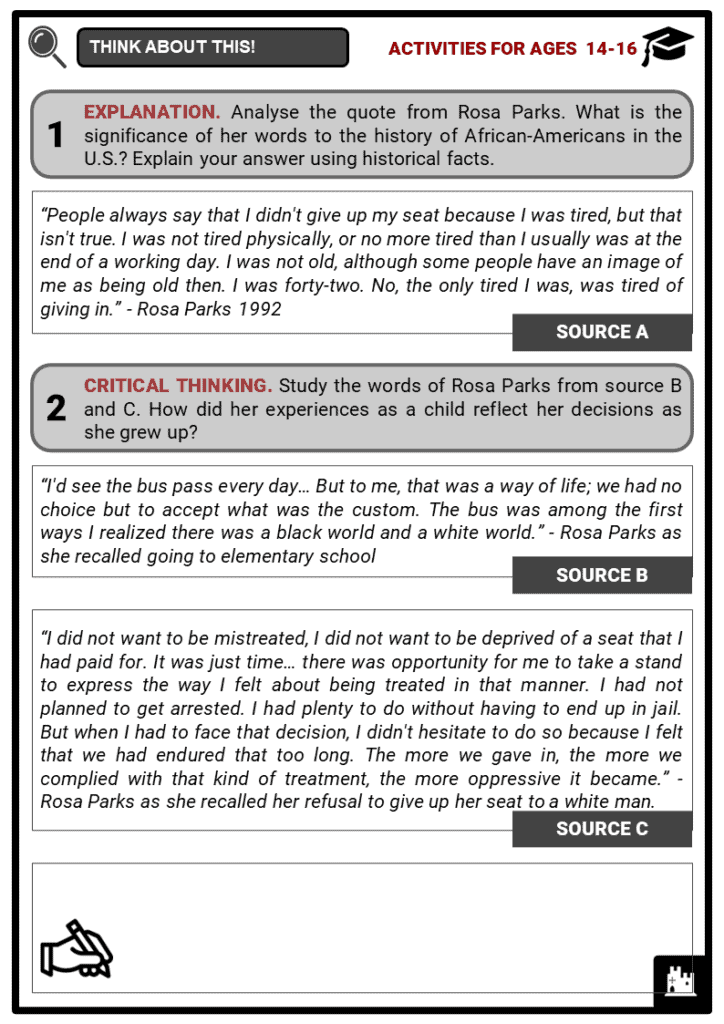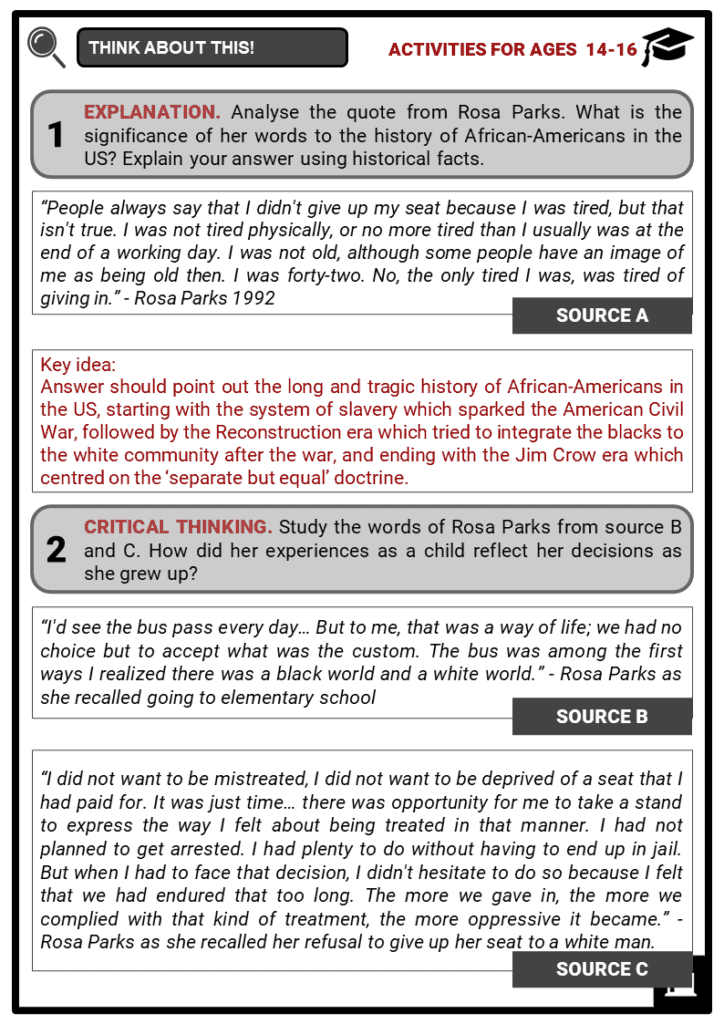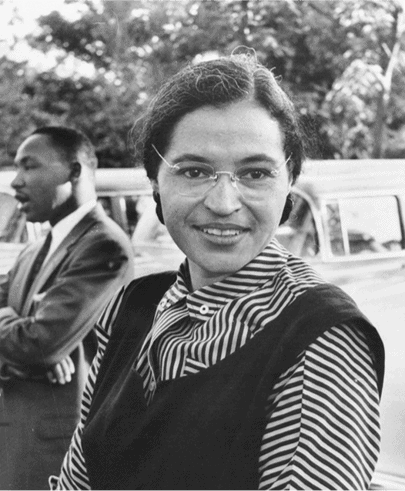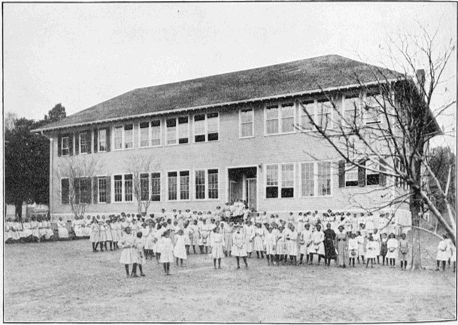Download Rosa Parks Worksheets
Do you want to save dozens of hours in time? Get your evenings and weekends back? Be able to teach Rosa Parks to your students?
Our worksheet bundle includes a fact file and printable worksheets and student activities. Perfect for both the classroom and homeschooling!
Table of Contents
Add a header to begin generating the table of contents
Summary
- Early life and education of Rosa Parks
- Marriage of Rosa Parks to Raymond Parks
- Events during and after the Montgomery Bus Boycott
- Death and legacy of Rosa Parks
Key Facts And Information
Let’s find out more about Rosa Parks!
- Rosa Parks was a well-known American activist in the civil rights movement. She is best known for her pivotal role in the Montgomery Bus Boycott, one of the largest social movements in history. Her activism made her recognised as "the first lady of civil rights" and "the mother of the freedom movement". Despite her death in 2005, her contributions to the civil rights movement was so immense, that up till now, she continues to be recognised all over the world as a symbol of freedom and equality.
Early Life And Education
- Rosa Louise McCauley was born on 4 February 1913 in Tuskegee, Alabama. Her mother, Leona McCauley, was a teacher, and her father, James McCauley, was a carpenter.
- When Rosa was still a child, she suffered from poor health due to chronic tonsillitis. Though she stayed at Tuskegee with her parents, she moved with her mother to Montgomery after her parents separated.
- There, she grew up on a farm, with her maternal grandparents, mother, and younger brother, Sylvester, who were all members of the African Methodist Episcopal Church (AME). This organization was founded by free blacks in Philadelphia in the early 1900s, and was a century-old independent black denomination.
- Rosa, until the age of eleven, attended rural segregated schools. She took academic and vocational courses at the Industrial School for Girls in Montgomery. In her autobiography, she recalls the time she was shown kindness by white strangers; although, more often than not, she could not ignore the racism in her society everytime she was bullied by white children in her neighbourhood.
- Later on, she attended a laboratory school set up by Alabama State Teachers College for Negroes. However, her education was short-lived, as she dropped out of school to take care of her grandmother and mother, both of whom had became ill.
Marriage
- In 1932, Rosa met and married Raymond Parks, who was a barber and an active member of the National Association for the Advancement of Colored People (NAACP).
- Her husband’s activism made Rosa actively involved in civil rights issues. She also joined the Montgomery chapter of NAACP in 1943. Until 1957, she particularly served as the chapter’s youth leader and secretary to NAACP President E.D. Nixon.
- Despite them not having children throughout their lifetime, Raymond and Rosa had a happy marriage.
Montgomery Bus Boycott
- On 1 December 1955, Rosa, who was riding a bus on Montgomery’s Cleveland Avenue from her work as a seamstress at a local department store, was arrested and fined 10 USD as she refused to give her front-row seat to a white man. The incident occurred when the 'white section' of the bus was full and the driver, James F. Blake, ordered African-Americans in the front row to vacate their seats.
- Rosa’s resistance set in motion one of the largest social movements in history, the Montgomery Bus Boycott. The Women's Political Council (WPC) members began mobilising the African-American people community, calling for a boycott of the Montgomery city buses. They distributed flyers and leaflets to reach all African-Americans to challenge the city ordinance.
- The boycott, which was organized by WPC President Jo Ann Robinson, gained the attention of the media, attracting more publicity. It was even advertised in the local newspaper, the Montgomery Advertiser.
- As the boycott continued to circulate in the media, landing on the front page of the Montgomery Advertiser, a general-interest newspaper, African-American leaders in Montgomery voiced their support. Black ministers also encouraged more supporters in church.
- On 5 December 1955, an estimate of 40,000 African-American bus riders responded to the boycott. That same afternoon, African-American leaders held a meeting to establish the Montgomery Improvement Association (MIA), during which Martin Luther King, Jr. was elected as the president.
- By 5 June 1956, a Montgomery federal court declared that any policies concerning racial segregation in city buses were against the law. The 14th Amendment of the U.S. Constitution stated that all citizens, regardless of race, should receive equal rights and protection.
- Following this, an appeal was filed by the city, but the U.S. Supreme Court affirmed the decision of the lower court, therefore declaring racial segregation as unconstitutional on 20 December 1956, which also happened to be the last day of the boycott.
Aftermath Of The Boycott
- Even after the integration, a number of white people refused to cooperate. Segregated bus stops in Montgomery were still maintained.
- In 1957, incidents of violence were recorded, led by the white supremacist group, the Ku Klux Klan, who bombed African-American churches and the homes of known African-American leaders, including that of Martin Luther King, Jr.’s.
- The boycott sparked more mobilisations and demonstrations, which contributed to the American civil rights movement. King Jr. continued to lead large-scale protests, gaining international attention.
- On 9 September 1957, the Civil Rights Act of 1957 was enacted, as proposed by President Eisenhower in Congress, signifying support of the national government for racial equality. Moreover, in 1965, the Voting Rights Act was passed, allowing African-American citizens to vote and participate in politics.
Life After The Boycott
- After the boycott, Rosa became an icon in the movement and was known as the “mother of the civil rights movement” and "the first lady of civil rights". The actual bus where she sat was displayed at the Henry Ford Museum in Michigan.
- 1960s
- Despite becoming an icon or symbol of the movement, Rosa suffered hardship following the events of the boycott. She lost her job at the department store and her husband Raymond was fired after his boss forbade him to talk about Rosa or their case.
- As they were unable to find work, they moved to Detroit, Michigan, where Rosa worked as a secretary and receptionist in U.S. Representative John Conyers’ congressional office. Moreover, she served on the board of the Planned Parenthood Federation of America.
- During the mid-1960s, Rosa participated in activism nationally by supporting the Selma--Montgomery March, the Freedom Now Party, and the Lowndes County Freedom Organization. She also befriended another civil rights icon, Malcolm X, whom she regarded as a personal hero.
- 1970s
- Rosa organized the freedom of political prisoners in the U.S., specifically the cases involving issues of self-defense. She also helped found the Joann Little Defense Committee Detroit chapter.
- Healthwise, Rosa’s family suffered in the 1970s as they were plagued with various illnesses. For one, she and her husband Raymond suffered stomach ulcers for years. Since their illness required hospitalization, they suffered financially as Rosa wasn’t a wealthy woman, despite her fame and speaking engagements. Most of the money she got from speaking to civil rights causes, she had donated. She and her husband lived off her staff salary and Raymond’s pension.
- In 1977, both Rosa’s husband and her brother died of cancer. Her close friend, Fannie Lou Hamer, also died that very same year. Rosa also suffered two broken bones from falling on an icy sidewalk. Her physical injury, together with the trauma caused by the death of her loved ones, caused her considerable and recurring pain.
- She decided to move in with her mother to an apartment for senior citizens where she nursed her through the final stages of cancer and geriatric dementia until her mother died in 1979 at the age of 92.
- 1980s
- Widowed and without a family, Rosa shifted her dedication back to civil rights and educational organisations. In the 1980s, she co-founded the Rosa L. Parks Scholarship Foundation for college-bound high school seniors.
- In 1987, she also co-founded, together with Elaine Eason Steele, the organization named ‘Rosa and Raymond Parks Institute for Self-Development’, to introduce young people to important civil rights and Underground Railroad sites in the country through "Pathways to Freedom" bus tours. Though her health was declining, she still served on the Board of Advocates of Planned Parenthood and continued to make appearances related to her advocacies.
- 1990s
- In 1992, Rosa published her autobiography entitled ‘Rosa Parks: My Story’ that recalled her difficult life in the racist South.
- In 1994, in the United States Interstate 55 in St. Louis County and Jefferson County, Missouri, a highway section near St. Louis, was named the ‘Rosa Parks Highway’. When Rosa was asked how she felt about this honor, she commented, "It is always nice to be thought of”.
- In 1995, she published her memoir entitled ‘Quiet Strength’ that focused on the role of religion throughout her life.
Death And Legacy
- In 2004, Rosa had been diagnosed with progressive dementia. On 24 October 2005, 92-year old Rosa died a natural death in her apartment in Detroit, Michigan. Her death was marked by several memorial services, among them the Capitol Rotunda in Washington, D.C. where about 50,000 people attended to view her casket. Shortly after her death, she was interred in the chapel’s mausoleum at Detroit’s Woodlawn Cemetery (later renamed the ‘Rosa L. Parks Freedom’ chapel).
- During her lifetime, she received many accolades, including NAACP’s highest award, the Spingarn Medal. She also received the prestigious Martin Luther King Jr. Award.
- On 15 September 1996, she was awarded by President Bill Clinton the highest honor given by the U.S. executive branch, the Presidential Medal of Freedom. In 1997, she was awarded the highest honor given by the US legislative branch, the Congressional Gold Medal.
- In 1999, TIME magazine named Rosa as one of “The 20 Most Influential People of the 20th Century”. Though she is long gone, Rosa’s contributions to the civil rights movement was so immense, that up till now, she continues to be recognised all over the world as a symbol of freedom and equality.
Image sources:

